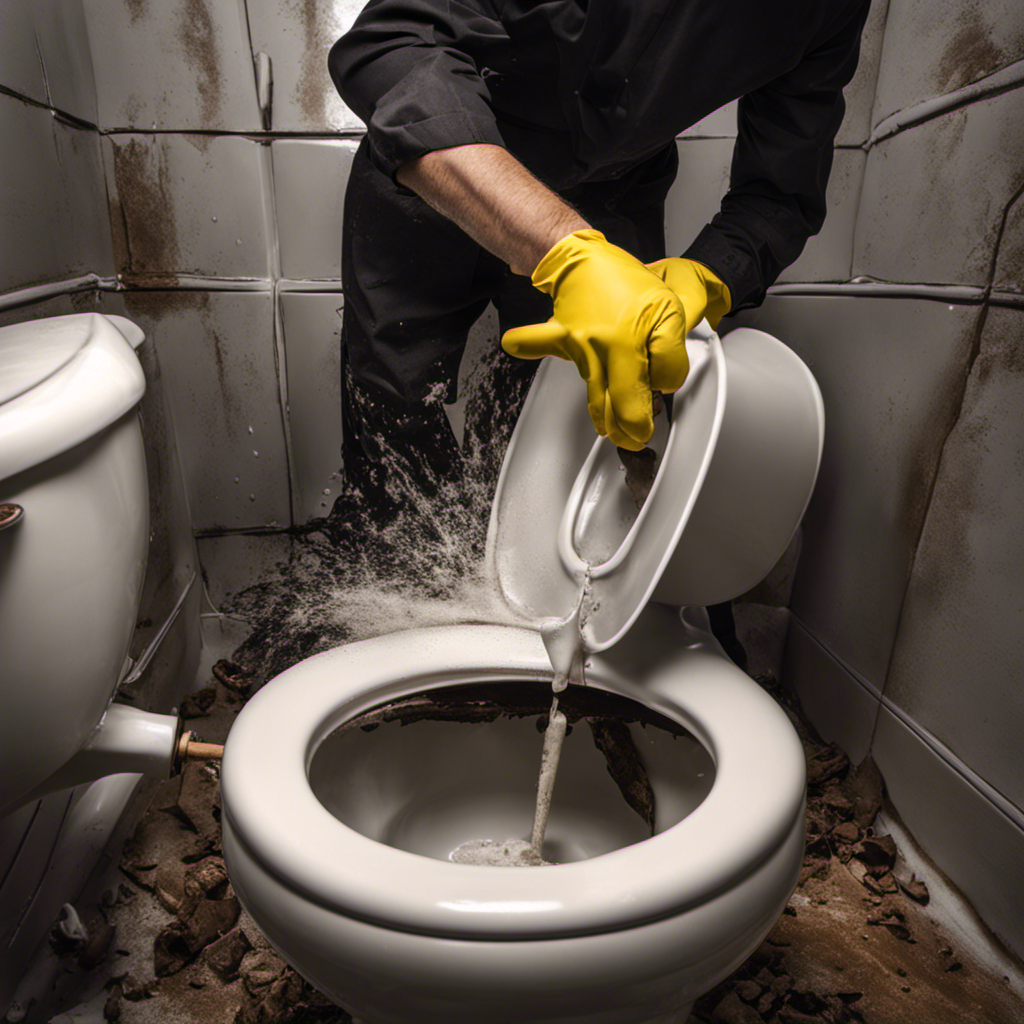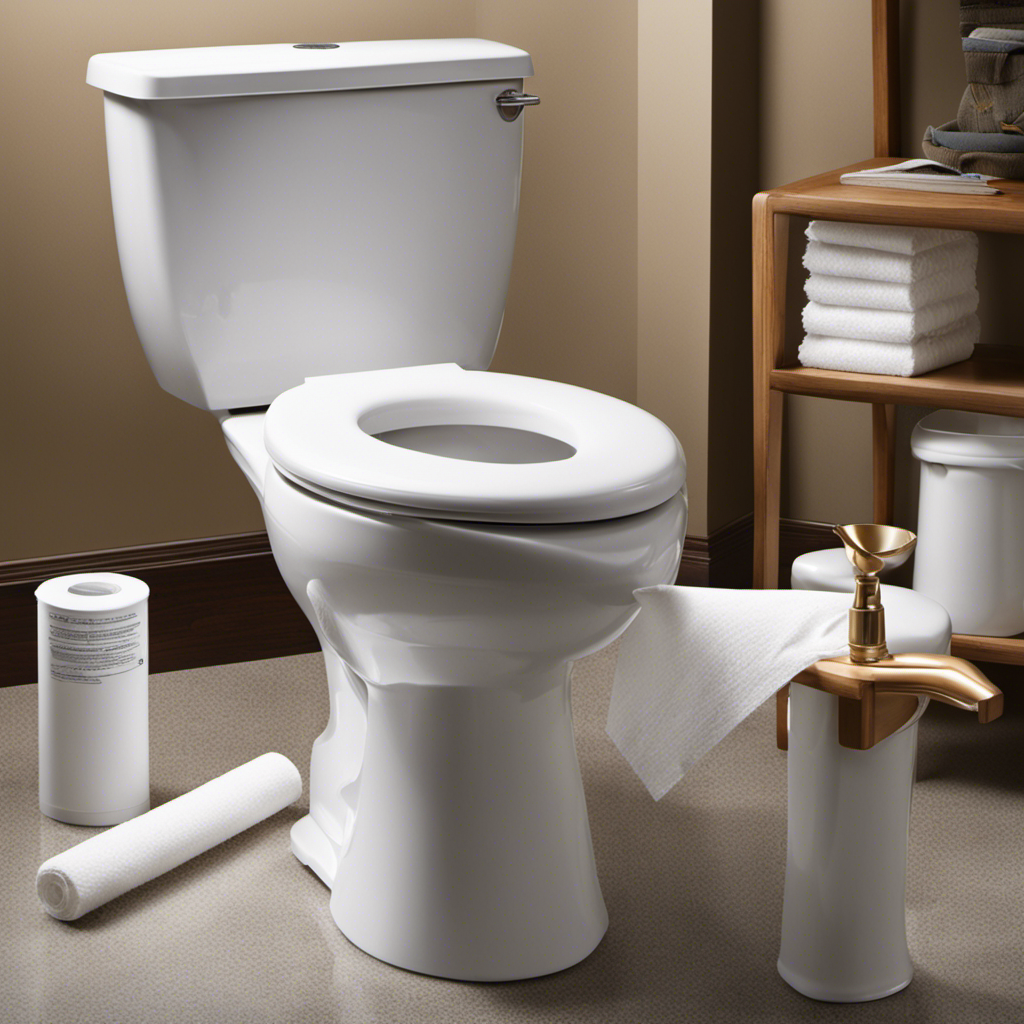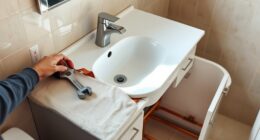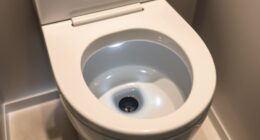As a seasoned plumber, I’ve encountered my fair share of challenges when it comes to unclogging toilets. There’s nothing quite like the frustration of a severely clogged toilet, but fear not!
In this step-by-step guide, I’ll walk you through the process of unclogging even the most stubborn blockages. From understanding the severity of the clog to gathering the necessary tools and materials, we’ll cover it all.
So grab your plunger and let’s get to work!
Key Takeaways
- Understanding the severity of the clog is crucial for determining the appropriate method for unclogging.
- Gather the necessary tools and materials before starting the unclogging process for a smooth experience.
- The essential tools for unclogging a severely clogged toilet are a plunger and a toilet auger.
- It is important to wear protective gear such as gloves, goggles, apron, and non-slip footwear to ensure safety during the unclogging process.
Understanding the Severity of the Clog
Before you attempt to unclog a severely clogged toilet, it’s important to understand the severity of the clog. This involves conducting a severity assessment and identifying the location of the blockage.
To assess the severity, start by observing the water level in the toilet bowl. If it’s close to overflowing or already overflowing, the clog is considered severe. Next, check if flushing the toilet results in any movement or drainage of water. If there is no movement or the water level remains unchanged, it indicates a more severe clog.
To identify the blockage location, use a toilet auger or a plunger to try and dislodge the clog. If the clog is easily removed, it might be located closer to the toilet bowl. If the blockage is harder to remove, it could be deeper in the pipes.
Understanding the severity and location of the clog is crucial in determining the appropriate method for unclogging the toilet.
Gathering the Necessary Tools and Materials
Before you can begin unclogging a severely clogged toilet, it’s crucial to gather the necessary tools and materials.
The essential tools needed for this task include a plunger, a toilet auger, and a bucket.
Additionally, you will need proper materials such as rubber gloves, towels, and a disinfectant cleaner.
It’s important to gather everything before starting to ensure a smooth and efficient unclogging process.
Essential Tools Needed
To unclog a severely clogged toilet, you’ll need a plunger and a toilet auger. Understanding the problem and utilizing troubleshooting techniques are crucial in successfully resolving the issue.
First, assess the severity of the clog. If the water level is rising, stop adding more water and proceed cautiously.
Begin by using a plunger to create a tight seal around the drain hole. Apply downward pressure and then pull up forcefully, repeating the motion several times.
If this doesn’t work, it’s time to bring in the toilet auger. Insert the auger into the drain hole and rotate the handle clockwise to break up the clog. Continue this process until the clog is cleared.
Remember to be patient and take breaks if needed.
Proper Materials for Unclogging
The essential tools you’ll need for unclogging a severely clogged toilet include a plunger and a toilet auger. When it comes to unclogging techniques, it’s important to have the right materials on hand to ensure a successful outcome.
A plunger is a basic tool that creates pressure to dislodge the blockage. Choose a plunger with a flange for better suction. A toilet auger, also known as a plumbing snake, is a long, flexible wire coil that can reach deep into the pipes to break up stubborn clogs.
Troubleshooting tips suggest using the plunger first, applying firm, steady pressure to create a vacuum and force the blockage out. If that doesn’t work, the toilet auger can be used to physically break up the clog.
With these tools in your arsenal, you’re ready to tackle even the most stubborn clogs.
Now that you know the proper materials for unclogging a severely clogged toilet, it’s important to gather everything before starting.
Gathering Everything Before Starting
Now that you’ve gathered all the necessary materials, it’s time to start tackling the clog.
Before diving into the unclogging process, it’s important to understand the severity of the clog. Is it a minor blockage or a severe one? This will determine the steps you need to take.
For a minor clog, you can start by using a plunger. Place it over the drain hole and give it a few firm pushes to create suction. If the clog persists, you can try using a toilet auger, inserting it into the drain and rotating it to break up the blockage.
For severe clogs, it may be necessary to remove the toilet and access the pipes directly. Remember to turn off the water supply before attempting this step.
Preparing the Toilet for Unclogging
When it comes to unclogging a severely clogged toilet, understanding the plunger technique is essential.
First, make sure you have a good quality plunger with a sturdy handle and a rubber cup.
Next, position the plunger over the drain hole and apply downward pressure, followed by rapid up and down motions.
It is crucial to wear protective gear such as gloves and goggles to prevent any potential splashing or contact with harmful substances.
If you don’t have a plunger on hand, there are common household alternatives that can be used, such as a mop or a bucket of hot water, which can help dislodge the clog.
Plunger Technique Explained
To unclog a severely clogged toilet, start by positioning the plunger over the drain hole and pushing down firmly and then pulling up quickly. This technique creates a suction that helps dislodge the blockage.
If you don’t have a plunger on hand, there are alternative methods you can try. One option is using a toilet auger, also known as a plumbing snake, which is a long, flexible tool that can reach deeper into the pipes to break up the clog.
Another method is using a mixture of hot water and dish soap. Pour a generous amount of dish soap into the toilet bowl, followed by hot water. Let it sit for a few minutes, then use a toilet brush to vigorously plunge the water. The soap helps to lubricate the pipes, making it easier for the clog to slide through.
Importance of Protective Gear
It’s important to wear protective gear when attempting to clear a blockage in your plumbing. The use of protective equipment is a necessity to ensure your safety while performing this task.
Here are some safety precautions to keep in mind:
- Safety goggles: Protect your eyes from splashing water or debris.
- Rubber gloves: Shield your hands from bacteria and harmful chemicals.
- Apron or coveralls: Prevent stains and contamination of your clothing.
- Respirator mask: Guard against inhaling harmful fumes or odors.
- Non-slip footwear: Provide stability and prevent accidents in wet environments.
By following these safety measures, you can reduce the risk of injury and protect yourself from potential hazards.
Now, let’s explore some common household alternatives that can be used to unclog a severely clogged toilet.
Common Household Alternatives
Looking for everyday items you may already have at home to help with a blockage? Try using baking soda and vinegar as a natural alternative to unclog your pipes.
This household remedy is effective for both mild and severe clogs. Here’s a step-by-step guide on how to use these natural remedies.
First, pour half a cup of baking soda into the clogged drain. Let it sit for a few minutes to break down the blockage.
Then, pour a cup of vinegar down the drain and immediately cover it with a plug or a cloth to create pressure. The chemical reaction between the baking soda and vinegar will help dissolve the clog.
Using Manual Methods to Clear the Clog
Start by grabbing a plunger and positioning it over the drain of the severely clogged toilet. Make sure to create a tight seal between the plunger and the drain. Apply firm downward pressure and then pull up quickly. Repeat this plunging motion several times to dislodge the clog.
If the plunger doesn’t work, try using a toilet auger. Insert the auger into the drain and rotate the handle clockwise to break up the obstruction.
Another method is to pour hot water into the toilet bowl. The heat can help to dissolve the clog. Be cautious not to use boiling water, as it may crack the toilet bowl.
If all else fails, you may need to call a professional plumber for assistance.
Trying Chemical Solutions for Stubborn Clogs
After attempting manual methods to clear a clogged toilet, you may consider trying chemical solutions for stubborn clogs. Chemical methods can be effective in breaking down the blockage and restoring proper flow. However, it is important to take safety precautions when using chemicals.
-
Choose the right chemical: Look for a toilet-specific drain cleaner or an enzyme-based cleaner that is safe for toilets. Avoid using harsh chemicals that can damage the toilet or harm the environment.
-
Follow instructions: Read and follow the instructions provided by the manufacturer. Wear gloves and protective eyewear to minimize contact with the chemicals.
-
Pour the solution: Carefully pour the recommended amount of the chemical into the toilet bowl. Avoid splashing or overflowing.
-
Wait and flush: Allow the chemical to work for the specified time. Then, flush the toilet to see if the clog has been cleared.
Preventing Future Toilet Clogs
To prevent future clogs, it’s important to be mindful of what you flush down the toilet and avoid using excessive amounts of toilet paper. Here are some key tips for toilet maintenance and effective unclogging methods:
-
Proper flushing: Only flush human waste and toilet paper. Avoid flushing items like wipes, feminine products, or paper towels, as they can cause clogs.
-
Regular cleaning: Keep your toilet clean by using a toilet brush and cleaner regularly. This helps prevent buildup and reduces the chances of clogs.
-
Water pressure maintenance: Ensure that your toilet has sufficient water pressure by checking the water supply valve. Adjust it if necessary to avoid weak flushes.
-
Regular inspections: Periodically inspect your toilet for any signs of leaks or cracks. These issues can lead to clogs and should be addressed promptly.
-
Professional help: If you experience persistent or severe clogs, it’s best to call a professional plumber. They have the expertise and tools to effectively unclog your toilet.
Frequently Asked Questions
Can I Use a Plunger to Unclog a Severely Clogged Toilet?
Yes, you can use a plunger to unclog a severely clogged toilet. However, if the plunger doesn’t work, there are alternative methods you can try. If all else fails, it may be time to call a plumber.
What Should I Do if the Clog Doesn’t Clear After Using Manual Methods?
If the clog doesn’t clear after using manual methods, it’s time to call a professional plumber. They have the expertise and tools to handle severe toilet clogs. Don’t hesitate to seek their help.
Is It Safe to Use Chemical Solutions to Unclog a Severely Clogged Toilet?
Using chemical solutions to unclog a severely clogged toilet can be effective, but there are pros and cons to consider. Safety precautions should be taken, such as wearing gloves and ensuring proper ventilation.
How Can I Prevent Future Toilet Clogs?
To prevent future toilet clogs, I take preventive measures. Knowing common causes helps. Being mindful of what goes down the toilet and regular maintenance can save me from dealing with severe clogs.
Are There Any Alternative Methods to Unclog a Severely Clogged Toilet?
There are alternative methods to unclog a severely clogged toilet, such as using a plunger or a toilet auger. If those methods don’t work, it’s best to seek professional help.
Conclusion
So there you have it, a step-by-step guide on how to unclog a severely clogged toilet.
By understanding the severity of the clog and gathering the necessary tools and materials, you can effectively prepare the toilet for unclogging.
Using manual methods and trying chemical solutions can help clear stubborn clogs. But remember, prevention is key.
By taking preventive measures, you can avoid future toilet clogs.
Stay tuned for more tips and tricks on maintaining a smoothly functioning toilet.










